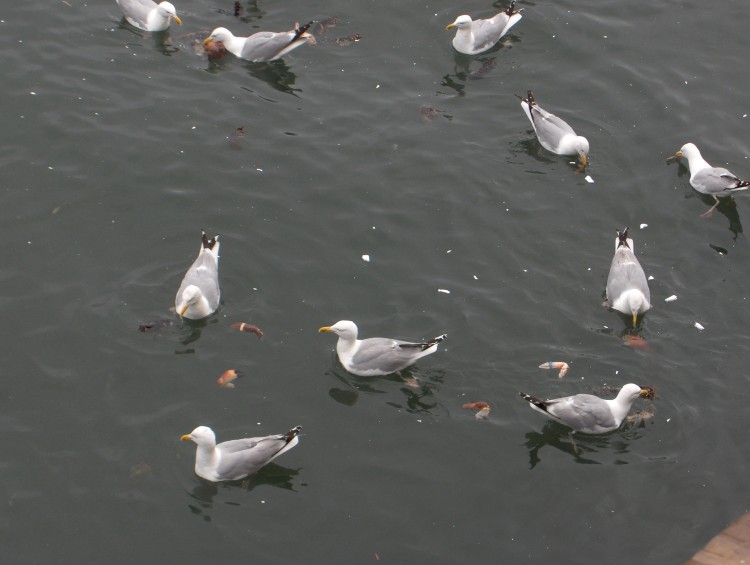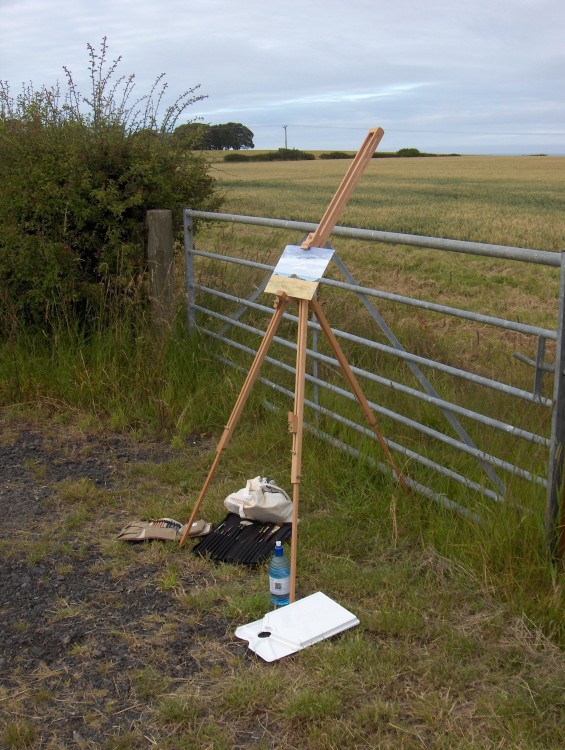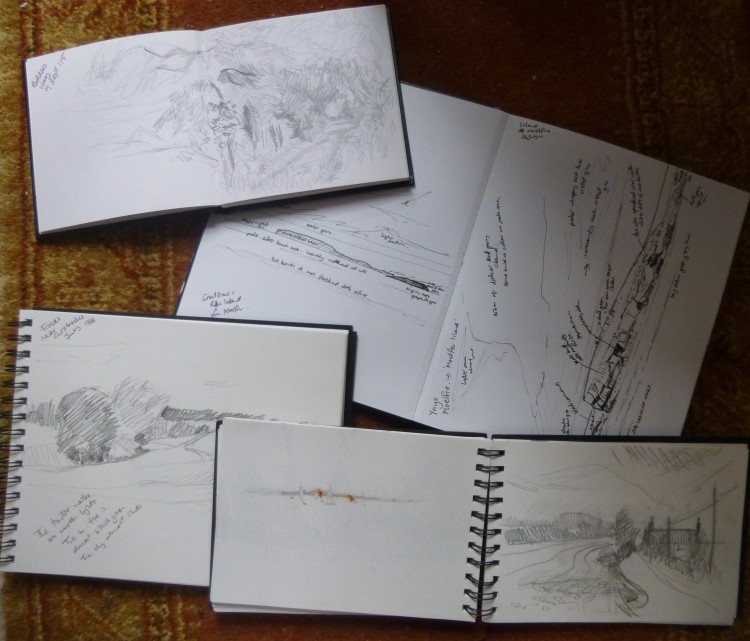Open Studios: questions that people asked: Part 1
During my Open Studios weekend at the end of September, I was struck by how many people asked the same questions. So I thought I’d do a few posts answering some of the most frequent queries.
Firstly: ‘Do you paint on the spot, or take photographs?’
A few years ago, I was told by a ‘knowledgeable person’ that I must always paint on the spot. So I bought a lightweight Field Easel and had a go. I was just about to have a holiday on the Northumberland coast, so I thought that would be a great time to start.
My very first ‘plein air’ painting was of the Farne Islands from the sand dunes just south of Bamburgh Castle. It wasn’t that far from where I had parked the car. Fortunately. . . . .
I carried my easel, and a couple of canvas boards, and my brushes in a brush wallet to protect them, and a bottle of water, and a container to put the water in, and my stay-wet palette, and a bag with all the tubes of paint that I thought I might need, and some kitchen roll for wiping the brushes.
The first problem was getting the easel to remain steady. The sand was very soft, and it was very windy.
The second problem was that the paint kept drying up on the palette – even though I was using the ‘stay-wet’ palette – because the sun was hot – and it was very windy (see above).
The third problem was that the paint didn’t dry quickly enough on the canvas. Usually I build up the painting in a series of layers, letting each one dry completely before I work on top of it, but that wasn’t possible, and I soon seemed to be wading about with my brushes and palette knife in a sticky mess.
And then the tide was going out fast, so the shapes and extent of the rocks kept changing, and the light constantly shifted as the clouds raced overhead.
It wasn’t a very happy experience – but undeterred I thought I’d try again.
This time it was at St Abb’s, further up the coast, over the border in Scotland. The little harbour jutted out into the wild sea, and there was a rugged coastline with various small islands. I set up my easel on the end of the harbour – much easier this time as it was on flat concrete. I was getting on a bit better when a fishing boat came into dock almost next to me, and a large refrigeration lorry backed up behind me, and I became surrounded by a flock of vociferous gulls, as the fishermen threw all sorts of odds and ends into the sea.
 The noise was deafening, but I tried to carry on, getting less and less pleased with the result. And when I packed up, there was the problem of transporting the very wet and sticky painting back to the car. I know you can get box easels for outdoor work that have a built in canvas holder, but even the ‘light’ ones are so heavy to carry.
The noise was deafening, but I tried to carry on, getting less and less pleased with the result. And when I packed up, there was the problem of transporting the very wet and sticky painting back to the car. I know you can get box easels for outdoor work that have a built in canvas holder, but even the ‘light’ ones are so heavy to carry.
I had one more go, the following day, a field sloping down to the sea, overlooking Lindisfarne. It was on the farm where I was staying, so not very far to carry everything.
 Again, I wasn’t very pleased with the results – it just seemed an awful lot of effort for a very bad painting!
Again, I wasn’t very pleased with the results – it just seemed an awful lot of effort for a very bad painting!
I tried again when I was on holiday in Cornwall, first on the cliffs at Pendeen. I nearly lost the easel into the sea – because it was very windy (see above, again!) . . . . . And then near Godrevy, looking at the lighthouse. A man came along the footpath, stood near me and watched for quite a while, before making the enigmatic comment ‘I can never paint skies . . . .!’
So, to come back to the question, ‘Do you paint on the spot, or take photographs?’
I don’t paint on the spot. I don’t like carrying all the stuff, I don’t like contending with the elements. But most importantly, I don’t like the way that I am forced to paint when I’m outside in front of a quickly changing scene, getting everything down over the whole canvas fast. And I don’t like the fact that there is no time to mull over what you’ve done so far, and see what the painting needs next, as a painting, to make it work.
So this is what I do instead. I draw on the spot and take photographs too. I have a range of sketchbooks, different sizes, some spiral bound to open flat, all hard back to make it easy to press on them.
 I take a little tin box which contains pencils in various grades, up to a thick 9B graphite stick, and some fine-liner pens and a pencil sharpener.
I take a little tin box which contains pencils in various grades, up to a thick 9B graphite stick, and some fine-liner pens and a pencil sharpener.
In my drawing I try to think about where the edges of the painting will be, what will make a strong composition, and I write notes for myself about the colours – sometimes even the paint-mix that I think will work. Then I take photographs, trying to match up the view in the camera with what I’ve drawn. And this always highlights the fact that we do not see like a camera. What we focus on, what interests us, we see as proportionately bigger than other areas of the ‘picture’. When I’m painting I go by what I’ve drawn, and just use the photographs, which I print out onto ordinary cheap A4 paper, for details and colours which I want to check on.
So, I hope that wraps up that question.
Yay! Friday tomorrow – hope you’ve had good week. 🙂
